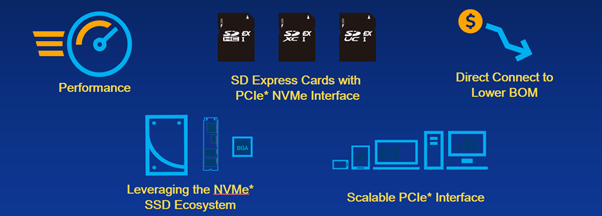PCIe® and NVMe™ solid state drives (SSDs) are the predominant solution in today’s client systems, used for storage in several applications. As PCIe/NVMe brings lower software stack overhead and reduces latency, it has become the most used interface in SSDs for desktops, laptops, all-in ones and two-in-ones. It is the preferred choice for servers, even in the largest data centers, and has also found usage in Internet of Things (IoT) and automotive.
The reasons for this are clear: NVMe provides a higher performance interface with a very robust ecosystem. The majority of innovation in storage is happening around NVMe, with fast introduction of new features that allow more flexibility, control and performance (whether it is defined as quality of service or throughput for the demanding workload). Additionally, billions of devices supporting PCIe ship every year – Qualcomm alone ships more than a billion.
Now, removable memory cards incorporate these solutions. SD 7.0, the latest SD memory card specifications released by the SD Association, includes the addition of the SD Express interface, which integrates the NVMe/PCIe interface with the SD form factor. By leveraging the high-speed interface commonly found in SSDs, SD Express revolutionizes data storage with a breakthrough transfer speed up to 985 MB/s while maintaining all the benefits of the SD form factor.
Why SD Memory Cards and PCIe/NVMe?
The overwhelming majority of devices, from phones to large servers, support PCIe. It has a very large and robust ecosystem, with many different companies participating in it. This allows for easy adoption of this with current systems on a chip. In addition, NVMe has become the leading storage standard with software stacks tuned for it, which allows new usages not previously realized with the SD memory Card.
The benefits of incorporating these solutions into SD Express are many:
- Higher performance, lower latency, lower CPU utilization, power management
- NVMe goodness: Same driver as an internal SSD; derive all features (like Redundant Array of Inexpensive Disks [RAID], power and performance, Intel® Optane™ memory)
- PCIe goodness: Common, scalable interface (phone – tablet – laptop – desktop)
- Direct connect (no bridge chip, lower bill of materials)

All of this is possible due to a triple threat of exciting innovations: the combination of new hardware capabilities, interface and platform solutions, plus redesigned software stacks.
The Triple Threat
- In terms of new hardware capabilities, SD Express allows a faster interface, starting at double the performance of the current SD interfaces. As it uses PCIe/NVMe, it can potentially scale with the number of lanes and/or adoption of future generations of PCIe. Currently, SD Express is using PCIe Gen3; use of Gen4 will double performance per lane, and Gen5 will double it again. This type of scaling opens new performance frontiers for SD memory cards.
- The software stack is expected to heavily leverage the NVMe software stack, providing a proven driver that is ready to go. All major operating systems natively support NVMe protocol, which eliminates the potential adoption barriers from the software stack point of view.
- Using the PCIe interface allows simplification from the platform perspective. Instead of adding UHS-II to gain additional performance, which was required in previous implementations, we can connect SD Express cards directly to one of the PCIe lanes available in the processor, chipset or system on a chip, which saves doing a separate interface design for faster SD accesses.
These three types of technology integrate well and work together to create the new SD Express capabilities. The NVMe standard provides the protocol and software driver needs, while PCIe provides the speed, low latency and ubiquitous interface to connect the CPU to the card. SD provides the mechanicals and infrastructure for SD Express, creating a modern usage of a card standard that has been around for 18 years.
SD Express: Solving New Challenges, Creating New Usages
Some challenges SD Express will solve include:
- Slow/inefficient (bandwidth, latency and higher CPU utilization)
- Multiple protocols with different drivers (eMMC, UFS, SATA, SAS, PCIe/NVMe) → align on single one – PCIe NVMe
- Extra cost to use in PC
- Usage limited to removable storage
Additionally, with removable cards now employing the PCIe/NVMe storage interface, new usages are created because the interface allows upgrades of storage capability with SSD-like performance. Any user can buy an SD Express card and instantly upgrade their system’s storage capacity easily, or use the card as an expansion slot.
For example, if a user buys a laptop with 500GB of storage and runs out of storage space after a year, that user could place an SD Express Card into the system to provide additional capacity for applications or data – without getting out a screwdriver and opening the box.
SD Express unleashes performance that was not available in previous generations, and SD Express memory cards with PCIe and NVMe protocol deliver portability, flexibility, scalability and ultra-low latency for reliable data storage and redundancy; future-proof infrastructure investment; agile analytics; and overall greater productivity and performance.
SD Express delivers the sequential and random performance for next-generation applications, making it suitable for multi-channel edge computing, including data acquisition from a diversity of sensors, data loggers and video sources; 360-degree virtual and augmented reality applications; and numerous automotive applications. The sky is the limit for what users will be able to do with SD Express – thanks to the triple threat of innovations that creates these new possibilities.
Anthony Constantine is a Platform and Storage Architect for Intel. Constantine can be reached at. anthony.m.constantine@intel.com. Jacek Wysoczynski is a Storage Software Strategic Planner for Intel. Wysoczynski can be reached at Jacek.Wysoczynski@intel.com.
PCI Express® is a registered trademark of PCI-SIG®.
NVM Express™ and NVMe™ are trademarks of NVM Express, Inc.
Intel® and Intel Optane™ are trademarks of Intel Corporation or its subsidiaries in the U.S. and/or other countries.
© SD Association. All rights reserved. SD, microSD, SDHC, microSDHC, SDXC, microSDXC, SDUC, microSDUC Logos are trademarks licensed by SD-3C LLC.



